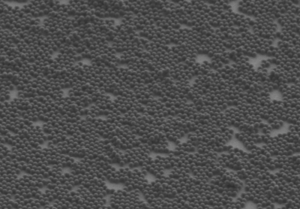New chip makes nanoplastics visible

Nanoplastic particles under scanning electron microscope (Image credit Dr Lukas Wesemann, University of Melbourne, and Mario Hentschel, University of Stuttgart)
September 9, 2025 – An international team from the University of Melbourne and the University of Stuttgart has developed a chip capable of detecting and counting nanoplastics. These particles, even smaller than microplas-tics, pose serious risks to health and the environment because they can penetrate food, water, and human organs. Until now, such particles could only be studied with costly electron microscopes, making large-scale monitoring impossible.
The new ‘optical sieve’ traps nanoplastics in cavities of matching size, down to 200 nanometers. They can then be seen and counted using only a standard microscope and a simple camera. According to Dr. Lukas Wesemann of the University of Melbourne, this approach opens the door to systematic monitoring of nanoplastic pollution.
The researchers are now exploring how to scale up the method into a practical environmental test, potentially offering the first affordable and widely accessible tool to track nanoplastics worldwide.









